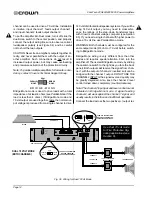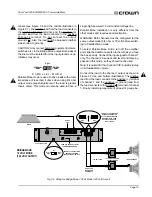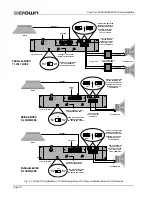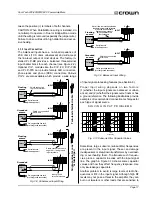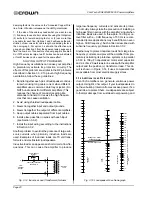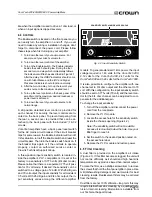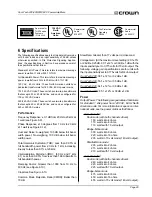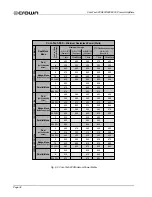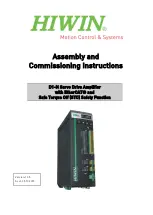
Page 24
Com-Tech 200/400/800/1600 Power Amplifiers
present conditions,
ODEP immediately limits the drive
level until it falls within the SOA. Limiting is proportional
and kept to an absolute minimum—only what is re-
quired to prevent output device damage.
This level of protection enables Crown to increase out-
put efficiency to never-before-achieved levels while
greatly increasing amplifier reliability.
The on-board intelligence is monitored in two ways.
First, the front panel
ODEP indicators show whether
the amplifier is functioning correctly or if
ODEP is limit-
ing the drive level. Second,
ODEP data is fed to the
connector inside the amplifier’s back panel
P.I.P. com-
partment so advanced
P.I.P. modules like the IQ-P.I.P.
can use it to monitor and control the amplifier.
This is how
ODEP keeps the show going with maxi-
mum power and maximum protection at all times.
4.3.2 Standby Mode
An important part of a
Com-Tech amplifier’s protection
systems is standby mode. Standby protects the ampli-
fier during potentially catastrophic conditions. It tem-
porarily removes power from the high-voltage supplies
to protect the amplifier and its loads. Standby mode
can be identified using the indicator table in Fig-
ure 4.1.
When you turn on the Enable switch, standby mode is
activated to provide
turn-on protection
. This power-up
delay lets other system components settle before any
signals are amplified, and it provides some “random-
ness” to the power-up sequence of multiple units which
reduces the system’s current demand during start-up.
If dangerous subsonic frequencies or direct current
(DC) is detected in the amplifier’s output, the unit will
activate its
DC / low-frequency protection
circuitry and
put the affected channels in standby. This protects the
loads and prevents oscillations. The unit resumes nor-
mal operation as soon as the amplifier no longer de-
tects dangerous low-frequency or DC output. Although
it is extremely unlikely that you will ever activate the
amplifier’s DC/ low-frequency protection system, im-
proper source materials such as subsonic square
waves or input overloads that result in excessively
clipped input signals can activate this system.
The amplifier’s
fault protection
system will put an ampli-
fier channel into standby mode in rare situations where
heavy common-mode current is detected in a
channel’s output. The amplifier should never output
heavy common-mode current unless its circuitry is
damaged in some way, and putting the channel in
standby mode helps to prevent further damage.
The amplifier’s
transformer thermal protection
circuitry
is activated in very unusual circumstances where the
unit’s transformer temperature rises to unsafe levels.
Under these abnormal conditions, the amplifier will put
both channels into standby mode. In addition, the
cooling fan will run at full speed. The amplifier will re-
turn to normal operation after the transformer cools to a
safe temperature. (For more information on trans-
former thermal protection, refer to the section that fol-
lows.)
4.3.3 Transformer Thermal Protection
All
Com-Tech amplifiers have transformer thermal pro-
tection which protects the power supplies from dam-
age under rare conditions where the transformer
temperature rises too high. A thermal switch embed-
ded in the power transformer removes power to the
high-voltage power supplies if it detects excessive
heat. The switch automatically resets itself as soon as
the transformer cools to a safe temperature.
If your amplifier is operated within rated conditions, it is
extremely unlikely that you will ever see it activate
transformer thermal protection. One reason is that
ODEP keeps the amplifier working under very severe
conditions. Even so, higher than rated output levels,
excessively low-impedance loads and unreasonably
high input signals can generate more heat in the trans-
former than in the output devices. This can overheat
the transformer and activate its protection system.
Com-Tech amplifiers are designed to keep working
under conditions where other amplifiers would fail. But
even when the limits of a
Com-Tech are exceeded, it still
protects itself—and your investment—from damage.
4.3.4 Circuit Breaker
A circuit breaker is provided to prevent excessive cur-
rent draw by the high-voltage power supplies. A reset
switch for the circuit breaker is provided on the back
panel. The rating of the circuit breaker for each ampli-
fier model and each AC mains voltage is provided with
the specifications in Section 6. When operating with
rated loads and output levels, this breaker should only
trip in the incredibly rare instance of a catastrophic
amplifier failure. Other protection systems such as
ODEP keep the amplifier safe and operational under
most other severe conditions. The breaker can also
trip in situations where extremely low-impedance
loads and high output levels result in current draw that
exceeds the breaker’s rating. Again, this should only
be possible when operating
outside rated conditions,





